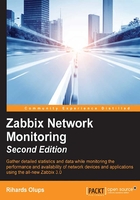
Conventions
In this book, you will find a number of text styles that distinguish between different kinds of information. Here are some examples of these styles and an explanation of their meaning.
Code words in text, database table names, folder names, filenames, file extensions, pathnames, dummy URLs, and user input are shown as follows: "One of the first monitoring solutions most administrators implement is a simple shell script invoked from a crontab that checks some basic parameters such as disk usage or some service state, such as an Apache server."
A block of code is set as follows:
memory_limit = 128M post_max_size = 16M max_execution_time = 300 max_input_time = 300 upload_max_filesize = 2M
When we wish to draw your attention to a particular part of a code block, the relevant lines or items are set in bold:
memory_limit = 128M post_max_size = 16M max_execution_time = 300 max_input_time = 300 upload_max_filesize = 2M
Any command line input or output is written as follows:
# rpm -ivh http://repo.zabbix.com/zabbix/3.0/rhel/7/x86_64/zabbix-release-3.0-1.el7.noarch.rpm
New terms and important words are shown in bold. Words that you see on the screen, for example, in menus or dialog boxes, appear in the text like this: "This screen doesn't offer us much to configure, so just click on Next step."
Note
Warnings or important notes appear in a box like this.
Tip
Tips and tricks appear like this.